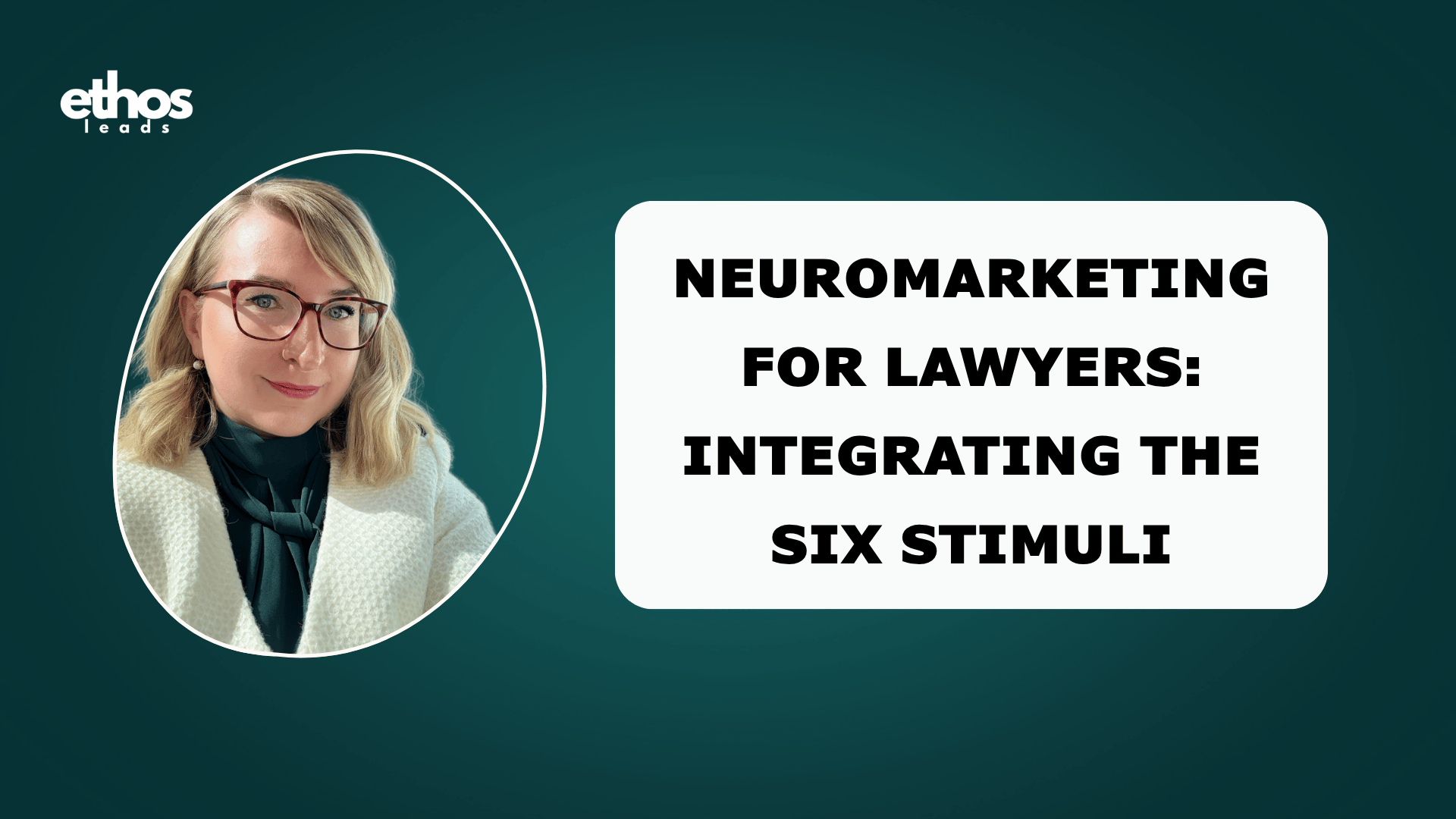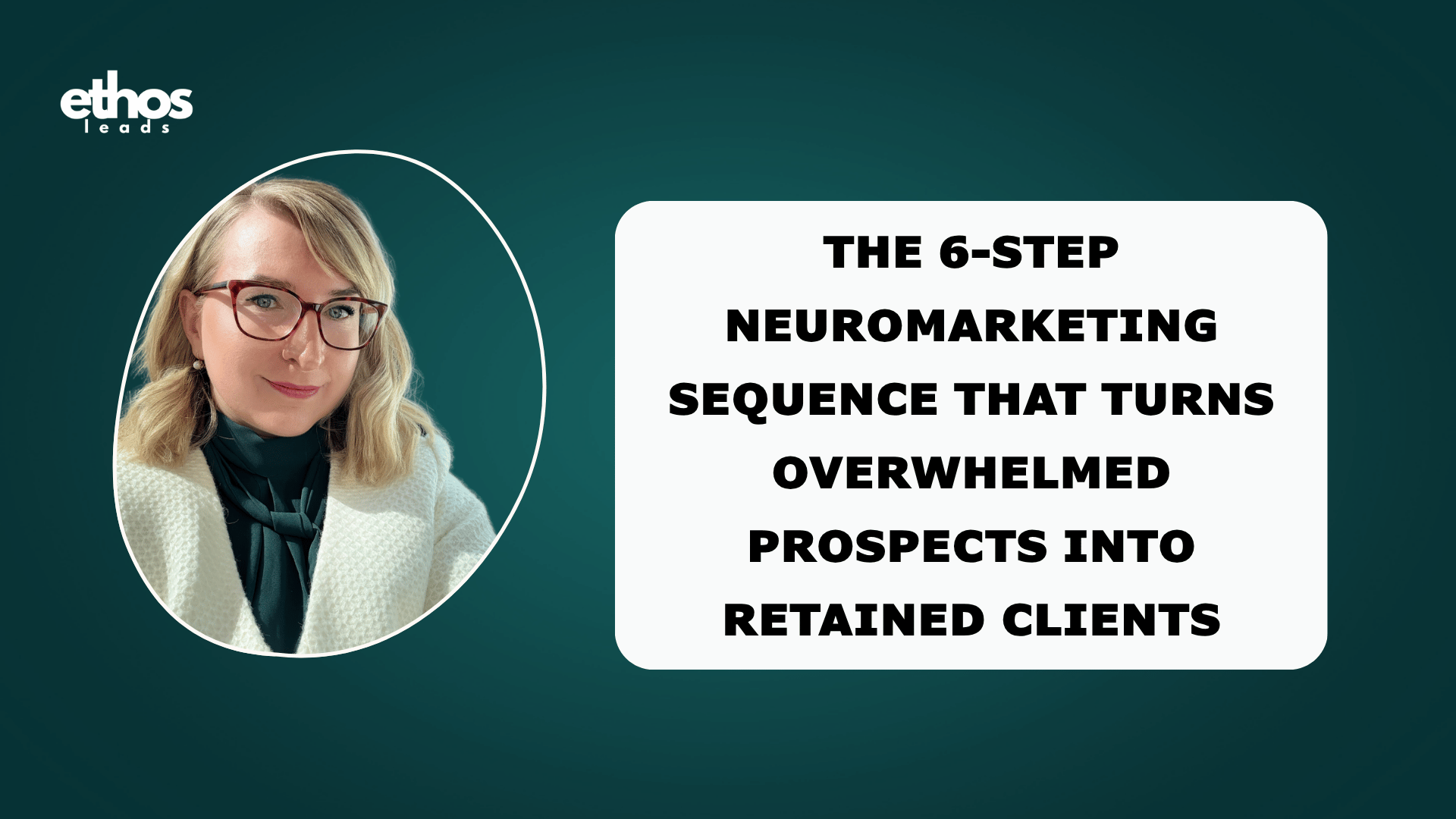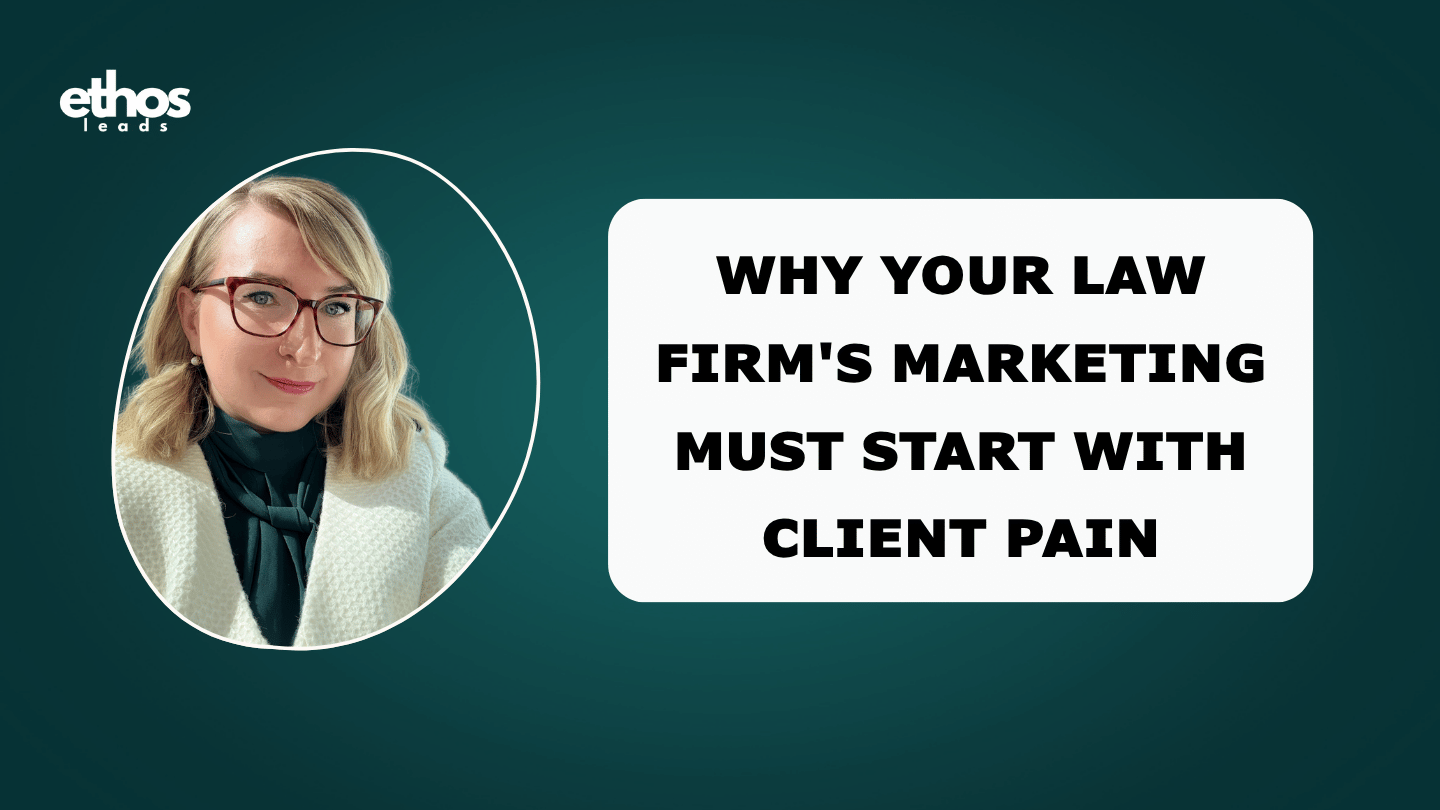Neuromarketing for Lawyers: Integrating the Six Stimuli
- Strategy
- 15 mins
How to Integrate All Six Stimuli Into One Persuasion Strategy
As legal professionals, you've mastered the art of logical argumentation and evidence-based persuasion in the courtroom. But when it comes to marketing your practice, these same analytical skills can work against you.
The reason lies deep within the human brain, specifically, in what neuroscientists call the “primal brain,” the ancient decision-making center that processes information far differently than the rational mind you're accustomed to addressing.
For lawyers, this means that no matter how compelling your credentials or case results, if you can't engage the primal brain first, your message will never reach the rational decision-making centers where your expertise can be fully appreciated.
Your potential clients make decisions based on primal brain responses long before their rational mind gets involved.
Marketing a law firm isn’t about outspending competitors or chasing the latest trend. It’s about understanding how people make decisions and speaking to that part of the brain where decisions actually happen.
Neuromarketing research shows that our primal brain, the oldest part of our nervous system, drives decisions emotionally first, then justifies them rationally later.
That’s where the Six Stimuli of Persuasion come in as discussed in The Persuasion Code by Christophe Morin and Patrick Renvoise.
On their own, each stimulus has limited effect. But when combined, they create a powerful sequence that captures attention, convinces, and closes.
Think of it like building a compelling sentence: each word matters, but the meaning only comes alive when they work together.
Why Integration Matters
Most lawyers market with scattered tactics: a LinkedIn post here, a website update there. But without strategy, those efforts don’t register with the primal brain.
Your prospective clients are busy, distracted, and often anxious. If your message doesn’t quickly move them from neutral to engaged, it gets ignored.
Individually, stimuli may spark curiosity. Integrated in sequence, they:
- Capture attention
- Convince with clarity and proof
- Close by creating urgency and emotional connection
That’s how you shift someone from “maybe later” to “I need to call this lawyer now.”
The Six Stimuli: Your Persuasion Code
Effective persuasion moves people through a specific journey in the brain. Research shows this happens along two dimensions: emotional engagement and rational engagement.
Most legal marketing makes a critical error: it tries to jump straight to rational persuasion without first creating emotional engagement. You present credentials, case results, and practice areas (all rational information) to an audience whose primal brain hasn't been activated yet. The result? Your message gets ignored, no matter how logically sound it is.
Research in neuromarketing has identified six specific stimuli that, when used together, create this persuasive journey. Each stimulus has limited impact alone, but combined properly, they work like a powerful sentence that speaks directly to how the brain processes information.
For lawyers, this means that weaving all six stimuli into your website, consultations, and marketing can transform how potential clients see you, trust you, and hire you.
The Six Stimuli in Sequence
Clients don’t start in a logical, rational state. They arrive overwhelmed, fearful, and distracted by competing priorities. To persuade ethically, you must:
- Capture attention (Visual + Personal).
- Convince with clarity (Memorable + Tangible).
- Close the decision (Contrastable + Emotional).
This sequence mirrors how persuasion moves from the primal brain (attention, survival) to the rational brain (reasoning, confirmation).

1. Visual: Capture Attention Instantly
The primal brain processes visuals in 13 milliseconds, far faster than text. Faces, body language, and images of client outcomes are more persuasive than words alone.
When someone lands on your website, their primal brain should immediately see what you offer, not just read about it.
Application for Lawyers:
- Use professional, approachable photos of yourself.
- Replace stock photos with real images of you and your team. Faces and expressions are primal magnets for attention.
- Include short, empathetic videos to introduce yourself and your services.
- Ask your clients for video testimonials.
- Use infographics to explain complex legal processes.
- Design clean, visually organized websites that guide the eye naturally.
Remember, the visual sense dominates the primal brain's decision-making process. A potential client will form an opinion about your firm within milliseconds of landing on your website, long before reading a single word about your experience.
Learn more about the Visual Stimuli.
2. Personal: Make It About Them
The primal brain is completely self-centered. Clients don’t want to know about your firm’s history; they want to know how you’ll solve their pain.
The first question in every client’s mind: “What’s in it for me?” Speak directly to their pain, survival, or desired gain.
This means shifting your messaging from “We provide comprehensive estate planning services” with “Protect your family's future when you're no longer here.” The shift from "we" to "you" activates the personal stimulus.
Application for Lawyers:
- Reframe firm-centered language (“We are a top-rated firm”) into client-centered messaging (“We’ll protect your rights and fight for your future”).
- Speak directly to pain points: fear of jail, losing children, debt stress, etc.
- Use “you” more than “we” in copy.
- Share client stories (with permission) that mirror your prospects' situations
- Create separate landing pages for different practice areas that speak to specific pain points
Learn more about the Personal Stimuli.
3. Memorable: Lead With Pain, Close With Relief
The primal brain remembers little. It needs repetition, structure, and narrative. What you say in the middle of your presentation gets forgotten, the primal brain prioritizes beginnings and endings. Stories activate memory better than facts alone.
For lawyers, this means: Structure your messaging around stories: client success stories, case narratives, or even the story of why you became a lawyer.
Application for Lawyers:
- Start with your client’s pain, end with hope.
- Transform case results into compelling client success stories.
- Use the classic three-act structure: problem, solution, resolution.
- Don't exceed three main points; the primal brain can't process more.
- Create memorable taglines that encapsulate your value proposition.
- Develop signature phrases or frameworks that clients can easily recall.
- Start consultations or videos with the client’s biggest fear or desire, not your credentials.
Learn more about the Memorable Stimuli.
4. Tangible: Make It Simple and Clear
Legal services are inherently intangible, which poses a challenge for the primal brain that prefers concrete, simple concepts. You must transform abstract legal benefits into tangible outcomes.
Make abstract legal services concrete with stories, metaphors, or step-by-step processes.
Application for Lawyers:
- Replace jargon (“comprehensive estate planning”) with real outcomes (“protecting your children's inheritance”).
- Use numbers and facts (“Over 300 families protected from foreclosure”).
- Provide timelines or flowcharts to simplify complex processes.
Learn more about the Tangible Stimuli.
5. Contrastable: Show Before/After
The primal brain is sensitive to contrast: before/after, risky/safe, with/without, slow/fast. Contrast enables quick, risk-free decisions. Without contrast, the brain enters confusion, which delays decision-making.
For lawyers, this means: Show the contrast between life with your services and life without them. What's the difference between representing themselves and hiring you? Paint the "before" picture clearly so the "after" becomes compelling.
Application for Lawyers:
- Clearly articulate what happens with you versus without you.
- Present clear before/after scenarios of client situations.
- Use comparison charts that highlight your unique advantages.
- Present fewer choices, guide clients toward one obvious solution.
Learn more about the Contrastable Stimuli.
6. Emotional: Close with Feeling
The primal brain is strongly triggered by emotions. We decide emotionally first and rationalize later.
While lawyers are trained to set emotions aside, effective marketing requires strategic emotional engagement.
Fear, trust, and hope are stronger motivators than logic. Clients hire you because of how you make them feel: safe, understood, confident.
For lawyers, this means: Connect to the emotions beneath the legal problem.
For example, estate planning isn't about documents; it's about fear of leaving family unprotected. Criminal defense isn't about statutes; it's about the terror of losing freedom. Speak to these emotions authentically (not manipulatively).
Application for Lawyers:
- Use client stories and testimonials that show real lives changed, not just outcomes achieved.
- Address the fear and uncertainty clients feel when facing legal issues.
- Share stories that trigger empathy and relief.
Learn more about the Emotional Stimuli.
The Recommended Sequence: Capture, Convince, Close
Using all six stimuli matters, but so does the order. Research suggests this sequence:
Capture Attention (Visual + Personal)
Start with a visual impact that immediately personalizes the message. Your prospect's brain needs to see something relevant to them within seconds.
Convince (Memorable + Tangible)
Once you have attention, provide structure through memorable stories backed by tangible evidence.
Close (Contrastable + Emotional)
Finish by highlighting the contrast between their current pain and your solution, while connecting to the emotional drivers of their decision.
This sequence ensures brain energy flows from the primal brain (attention) to the rational brain (confirmation), making your message not just noticed but trusted.
Practical Implementation for Your Practice
Start by auditing your current marketing materials against these six stimuli. Score each element from 1-10:
- How visual is your website homepage?
- How personal is your messaging?
- How memorable are your client success stories?
- How tangible are your service descriptions?
- How much contrast do you create versus competitors?
- How effectively do you trigger appropriate emotions?
Any stimulus scoring below 7 represents an opportunity for improvement. Remember, the compound effect of all six stimuli working together is exponentially more powerful than any single element optimized in isolation.
Practical Application for Law Firms
Let's apply this to a common scenario: your law firm website's homepage.
Current Approach (Most Law Firms):
A formal photo of the office building, followed by "Welcome to Smith & Associates. We are a full-service law firm with 30 years of experience providing comprehensive legal solutions..."
Primal Brain Approach:
- Visual: Show a client's face expressing relief after resolution (real photo with permission, not stock)
- Personal: "Facing criminal charges? Your future depends on what you do next."
- Memorable: Brief three-sentence story of a client's journey from arrest to case dismissal
- Tangible: "87% of our clients avoid jail time. Average case resolution: 4 months."
- Contrastable: "Without proper representation, even first-time offenders face average sentences of 18 months. Our clients face an average of 0 months."
- Emotional: "Your family needs you home. Let's fight to keep you there."
Notice the difference? The second version activates the primal brain at every step, creating engagement before asking for rational evaluation.
Practical Examples:
1) A Criminal Defense Lawyer
Imagine applying all six stimuli:
- Visual: The lawyer appears in a video calm, direct eye contact, professional.
- Personal: “You’re worried this mistake could ruin your future.”
- Memorable: Opens with fear: “One charge can follow you for life.” Closes with hope: “We’ll fight to protect your freedom.”
- Tangible: Explains step-by-step what will happen if they take the case.
- Contrastable: “Without representation, you risk jail time. With us, you gain a second chance.”
- Emotional: Ends with trust and anticipation: “You don’t have to face this alone. We’ll stand by you every step of the way.”
This sequence captures attention, convinces with clarity, and closes with emotional confidence.
2) How an Immigration Lawyer Could Present the $100K H-1B Fee Using the Six Stimuli
Let me show you two versions of a LinkedIn post about this significant policy change:
Traditional Approach (What Most Lawyers Post)
"H-1B Fee Increase Alert
Effective immediately, USCIS has announced a new $100,000 one-time fee per H-1B petition. This represents a significant increase in the cost of sponsoring foreign workers.
Employers should factor this into their hiring budgets and immigration planning. Our firm can assist with compliance and cost-benefit analysis for your immigration programs.
Contact us to discuss how this impacts your organization.”
Why This Fails: Dry announcement, no emotional hook, unclear implications, no visual element, forgettable.
Neuromarketing Approach (Six Stimuli Integrated)
[VISUAL - Lead with stark visual contrast]
Post includes: Simple graphic showing:
"What Hiring a Software Engineer Used to Cost vs. Now"
Old: $5,000 in fees | New: $105,000 in fees
[PERSONAL - Make it immediately relevant]
Your offer letter just became $100,000 more expensive.
If you're a hiring manager who made promises to international candidates last month, we need to talk.
[MEMORABLE - Structure with three clear scenarios]
This creates three immediate situations:
Situation 1: You Already Made Offers
If you extended offer letters with H-1B sponsorship before this announcement, you're in a legal gray area. Your offer letter probably said "we will sponsor your H-1B visa" but didn't specify the fee structure.
Can you rescind? Technically yes. Should you? That's a business ethics question, not a legal one. But understand: word spreads fast in international talent communities.
Situation 2: You Have Applications In Process
If you filed H-1B petitions before the announcement, you're likely grandfathered under old fees. But if you're planning extensions or transfers, we need to analyze whether the new fee applies. The guidance is murky.
Situation 3: You're Planning Future Hires
Your entire talent acquisition strategy just changed. The companies that win will be those who restructure their approach in the next 30 days, not the ones who wait and react.
[TANGIBLE - Break down the real numbers]
Here's the actual cost breakdown for hiring ONE H-1B employee now:
- Base filing fees: $5,000
- New one-time fee: $100,000
- Attorney fees: $5,000-8,000
- Premium processing (if needed): $2,805
Total first-year immigration cost: $112,805+
For a team of 5 H-1B employees: $564,025
That's more than most seed-stage startups raise in their first round.
[CONTRASTABLE - Create immediate, stark contrast]
Let's be clear about what changed overnight:
Last week:
Hiring an H-1B engineer cost roughly the same as hiring a U.S. worker
Small companies could afford to sponsor talent
Your $120K salary offer included ~$5K in immigration fees
This week:
Same engineer now costs $220K in year one
Only well-funded companies can play
Every H-1B hire is now a six-figure strategic decision
[EMOTIONAL - Close with empathy and resolution]
This change has left many business owners anxious, wondering if their growth plans are over. My role is to help you turn that anxiety into clarity and action so you can keep building your team without fear of making a costly mistake.
If you’re an employer planning for next year’s H-1B cycle, now is the time to start the conversation.
Why This Version Works:
- Starts with a shocking visual hook (the number).
- Makes it personal by tying it to the reader’s business survival.
- Creates memorable scenarios.
- Breaks it down into tangible examples.
- Shows the contrast (last week vs. this week).
- Ends with an emotional lift (from fear to clarity).
Common Mistakes Lawyers Make
Mistake #1: Leading with Credentials
Your degrees and experience matter, but not first. The primal brain doesn't care about your résumé until it cares about you. Activate engagement first, then provide credentials as tangible proof.
Mistake #2: Avoiding Emotional Language
Many lawyers fear that emotional messaging seems unprofessional. But the research is clear: no emotion means no retention and no decision. You can be both professional and emotionally resonant.
Mistake #3: Overcomplicating the Message
Legal issues are complex, but your marketing shouldn't be. The primal brain shuts down when overwhelmed.
Mistake #4: Ignoring Visual Communication
Text-heavy websites and brochures fail because they ignore how the brain actually processes information. Visual isn't optional, it's primary.
Mistake #5: Talking About Yourself Instead of Them
Every "we" should be a "you." Every firm-focused message should be client-focused.
Why This Matters for Small Firms
As a solo or small firm owner, you don’t have a six-figure ad budget. You can’t afford to waste money on scattershot marketing. But by using neuromarketing strategically, you can out-persuade bigger firms with fewer resources.
Neuromarketing isn't about manipulation; it's about communication that respects how the human brain actually works.
Start by auditing one piece of marketing: your homepage, your intake call script, or your consultation presentation. Ask:
- Is it visual or text-heavy?
- Is it about me or about them?
- Is it memorable or forgettable?
- Is it tangible or abstract?
- Does it show contrast or just make claims?
- Does it connect emotionally or stay purely rational?
Then redesign using the six stimuli in sequence. You'll likely find that effective neuromarketing doesn't require more content; it requires better structured, brain-aligned content.
The goal isn't to trick people into hiring you. It's to ensure that when someone needs your services, your message actually reaches them by speaking the language their brain understands best.
Because the most ethical marketing isn't the most restrained, it's the most effective. When you help people who genuinely need your services find you and choose you, everyone wins.
Related Articles:
Neuromarketing for Lawyers: An Ethical and Practical Guide for Solo and Small Law Firms
Neuromarketing for Lawyers: Personal Stimuli
How Personal Stimuli Convert More Clients
Neuromarketing for Lawyers: Contrastable Stimuli
Neuromarketing for Lawyers: Tangible Stimuli
Neuromarketing for Lawyers: Memorable Stimuli
Neuromarketing for Lawyers: Visual Stimuli
Neuromarketing for Lawyers: Emotional Stimuli
Neuromarketing for Lawyers: Integrating the Six Stimuli
FAQs About Integrating the Six Stimuli
- Can I use just one or two stimuli and still be persuasive?
Not effectively. Each stimulus has limited impact alone. Together, they create the persuasion code. - What’s the right order to use the stimuli?
Follow the recommended sequence: Visual → Personal → Memorable → Tangible → Contrastable → Emotional. - Is this manipulative?
Not if done ethically. You’re not creating fear, you’re addressing real client pain and offering real solutions. - What’s the biggest mistake lawyers make in persuasion?
Overloading with facts and jargon. The primal brain rejects complexity; simplicity wins. - How do I integrate this into my website?
- Use real lawyer photos (Visual).
- Client-centered headlines (Personal).
- Simple, sticky taglines (Memorable).
- Proof and case results (Tangible).
- Before-and-after scenarios (Contrastable).
- Emotional calls-to-action (Emotional).





